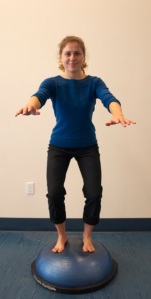- Falls are the leading cause of death from an injury in persons over 65
- 75% of emergency visits are fall-related
- 40% of hospital admissions in persons over 75 are the result of fall-related injuries
Technical Stuff
Definitions:
- Balance is a complex process involving the reception and integration of sensory inputs, and the planning and execution of movement, to achieve a goal requiring upright posture. It’s the ability to control the center of gravity over the base of support in any given sensory environment.
- Reflexes are automatic responses by the peripheral or central nervous system to help support postural orientation; they occur rapidly enough to not be under volitional control
Balance comes from 3 places
- Visual System: helps us see things in the environment and orient us to the hazards and opportunities presented
- Vestibular System (the inner ear): provides the brain with information about the position and motion of the head in relation to gravity; it contributes directly to postural stability
- Proprioceptors/somatosensory receptors: located in joints, ligaments, muscles, and the skin
Balance is also dependent on:
- Strength
- Good flexibility
- Reflexes and motor planning
When Things Go Wrong
- The Brain needs input from all 3 systems (visual, vestibular, proprioception) to distinguish motion of the self from motion of the environment
- Nausea, vomiting, dizziness often result as a mismatch in inputs
- It takes the brain a little “extra work” to deal with mismatches
- Example: When sitting in car at a stoplight and seeing car next to you creeping forward, you slam on your brakes
- Example: When you are boating, proprioceptors perceive a rocking boat under your feet, but your eyes just see a steady horizon
- there may be medical reasons why one of the three systems are not functioning like a stroke or diabetes or just poor vision. Make sure you are getting the help you may need to address these problems whether it is from a Physical Therapist, Doctor, or Optometrist
Treatment
Use it or lose it! Through practice and repetition, you can help the brain get used to these mismatches and be able to distinguish when the mismatch means trouble, or when it’s OK.
Do your routine 3 times a day, 10-20 reps to get your brain reprogrammed.
It may be a quick routine that only takes 5-10 minutes.
Extrinsic Risk Factors to Address
- Check your environment: loose cords and rugs can pose threats
- Does your home have adequate lighting, adequate space?
- More injuries and falls are likely in crowded situations
Exercises

Stand on BOSU or Wobble Board or Trampoline
Ways to increase the difficulty with the above exercises:
- Close the eyes
- Swing the arms, Spiraling, Reaching outside of your center of gravity
- Tossing an object with a friend or bounce one against a wall
- Scanning your eyes and turning your head from side to side
Vestibular Exercises
- Walk and read
- Walk while reading a moving book
- Walk and turn head while reading
- Walk and turn head with eyes closed
As always, we are here at Active Marin to help you through an individualized program to enhance your balance, whether to prevent another potentially debilitating fall, or improve your performance in your favorite sport.
call us at 415 385 3755 or email us at info@activemarin.com for an appointment or more info


